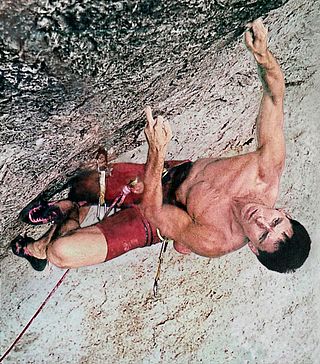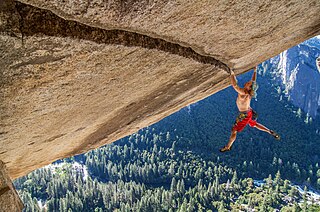
Many climbing routes have a grade that reflects the technical difficulty – and in some cases the risks and commitment level – of the route. The first ascensionist can suggest a grade, but it will be amended to reflect the "consensus" view of subsequent ascents. While every country with a strong tradition of climbing developed its own grading systems, a small number of grading systems have become internationally dominant for each type of climbing, which has contributed to the standardization of grades worldwide.

Friedrich Wolfgang Beckey, known as Fred Beckey, was an American rock climber, mountaineer and book author, who in seven decades of climbing achieved hundreds of first ascents of some of the tallest peaks and most important routes throughout Alaska, the Canadian Rockies and the Pacific Northwest. Among the Fifty Classic Climbs of North America, seven were established by Beckey, often climbing with some of the best known climbers of each generation.

Lhotse is the fourth highest mountain in the world at 8,516 metres (27,940 ft), after Mount Everest, K2, and Kangchenjunga. The main summit is on the border between Tibet Autonomous Region of China and the Khumbu region of Nepal.

A climbing route is a path by which a climber reaches the top of a mountain, or rock/ice-covered obstacle. The details of a climbing route are recorded in a climbing guidebook and/or in an online climbing route database, and will include elements such as the type of climbing route, the difficulty grade of the route – and its crux(es) – and any risk or commitment grade, the length and number of pitches of the route, and the type of climbing equipment needed to complete the route.

Sport climbing is a type of free climbing in rock climbing where the lead climber clips into pre-drilled permanent bolts for their protection while ascending a route. Sport climbing differs from the riskier traditional climbing where the lead climber has to insert temporary protection equipment while ascending.

Frog Buttress is a cliff on the north-west side of Mount French, in the Moogerah Peaks National Park near the town of Boonah in Queensland, Australia. It became famous when local rock climbers Rick White and Chris Meadows discovered it in 1968. Since then, 400 routes have been established by climbers including Henry Barber, Kim Carrigan and Tobin Sorenson.

The Trango Towers are a family of rock towers situated in the Gilgit-Baltistan region, in the northern part of Pakistan. The Towers have some of the world's largest cliffs and offer some of the most challenging big wall climbing opportunities. Each year, climbers from around the world embark on expeditions to the Karakoram region to climb these granite faces. The Trango Towers are situated to the north of the Baltoro Glacier and are part of the Baltoro Muztagh, which is a sub-range within the Karakoram mountain range. The highest point within the group is the summit of Great Trango Tower at 6,286 m (20,623 ft), the east face of which features the world's greatest nearly vertical drop.

Wolfgang Güllich was a German rock climber, who is considered one of the greatest and most influential climbers in the history of the sport. Güllich dominated sport climbing after his 1984 ascent of Kanal im Rücken, the world's first-ever redpoint of an 8b (5.13d) route. He continued to set more "new hardest grade" breakthroughs than any other climber in sport climbing history, with Punks in the Gym in 1985, the world's first-ever 8b+ (5.14a), Wallstreet in 1987, the world's first-ever 8c (5.14b), and with Action Directe in 1991, the world's first-ever 9a (5.14d).

Mount Arapiles is a rock formation that rises about 140 metres (460 ft) above the Wimmera plains in western Victoria, Australia. It is located in Arapiles approximately 10 kilometres (6.2 mi) west of the town of Natimuk and is part of the Mount Arapiles-Tooan State Park. Arapiles is a very popular destination for rock climbers due to the quantity and quality of climbs. It is one of the premier climbing sites in Australia along with the nearby Grampians. The Wotjobaluk name for the formation is Djurid.
The Mount Arapiles-Tooan State Park is a state park in the Wimmera plains of western Victoria, Australia. It encompasses Mount Arapiles, Mitre Rock, and the Tooan block. The park covers an area of 7,475 hectares and is valuable for nature conservation, with approximately 14% of the State's flora species represented in the Mount Arapiles area.

Henry Barber is an American rock climber and ice climber who rose to prominence in the 1970s. Known by the nickname "Hot Henry", Barber was an advocate of clean climbing, a prolific first ascenscionist and free soloist. He was one of the first American rock climbers to travel widely to climb in different countries, and was one of the first "professional" American rock climbers, supporting himself as a sales representative for outdoor equipment companies including Chouinard Equipment and Patagonia, and by giving lectures and slide shows. He was an integral member of the "Front Four" quartet of the 1970s: "Hot Henry", John Stannard, Steve Wunsch, and John Bragg.

In the history of rock climbing, the three main sub-disciplines—bouldering, single-pitch climbing, and big wall climbing—can trace their origins to late 19th-century Europe. Bouldering started in Fontainebleau, and was advanced by Pierre Allain in the 1930s, and John Gill in the 1950s. Big wall climbing started in the Dolomites, and was spread across the Alps in the 1930s by climbers such as Emilio Comici and Riccardo Cassin, and in the 1950s by Walter Bonatti, before reaching Yosemite where it was led in the 1950s to 1970s by climbers such as Royal Robbins. Single-pitch climbing started pre-1900 in both the Lake District and in Saxony, and by the late-1970s had spread widely with climbers such as Ron Fawcett (Britain), Bernd Arnold (Germany), Patrick Berhault (France), Ron Kauk and John Bachar (USA).
Michael Fowler is a British rock climber, ice climber, mountaineer and climbing author. He is internationally noted for his alpine climbing, and was awarded the Piolet d'Or three times, with Paul Ramsden, in 2003, 2013, and 2016, for alpine-style first ascents of faces in the Himalayas. Fowler was one of the first British rock climbers to free an E6-graded traditional rock climbing route, and the first ice climber to free a consensus grade VI mixed climbing Scottish winter route.

Big wall climbing is a form of rock climbing that takes place on long multi-pitch routes that normally require a full day, if not several days, to ascend. Big wall routes are typically sustained and exposed, where the climbers remain suspended from the rock face, even sleeping hanging from the face, with limited options to sit down or escape unless they abseil back down the whole route. It is therefore a physically and mentally demanding form of climbing.

Separate Reality is a 66-foot (20 m) traditional climbing route in Yosemite National Park in California. The route is known for its exposed and dramatic crux that consists of a 20-foot (6.1 m) long crack in its horizontal roof. When it was first free-climbed by Ron Kauk in 1978, it was one of the first climbs in the world to have a grade of 7a+ (5.12a). In 1986, German climber Wolfgang Güllich free soloed the route, and the photographs by Austrian Heinz Zak become iconic in rock climbing history.

Mixed climbing is a climbing discipline used on routes that do have not enough ice to be pure ice climbs, but are also not dry enough to be pure rock climbs. To ascend the route, the mixed climber uses ice climbing tools, but to protect the route, they use traditional or sport rock climbing tools. Mixed-climbing can vary from routes with deep layers of ice and some exposed rock sections to routes that have no deep layers of ice, but where the rock is still covered in ice and/or snow.

Geoff Weigand is an Australian rock climber and road cyclist.
Mike Law is an Australian rockclimber known for establishing routes across Australia, especially in the Blue Mountains.
Robert Andrew Pollitt was a British rock climber who was one of the most prominent traditional climbers and sport climbers of the late 1980s and early 1990s. In 1992, after having successfully repeated Punks in the Gym in Australia, the world's first-ever 8b+ (5.14a) graded sport climbing routes, he quit climbing and permanently emigrated to Australia. In 2016, Pollitt published an autobiography, titled Punk in the Gym. He died from a cerebral aneurysm on 13 November 2019.














